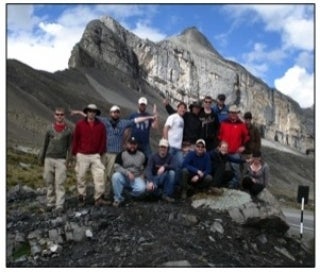News
Filter by:
Geology of the University of Waterloo campus
Homer Watson Park geology
What on Earth: Volume 7 2011
Kitchener: The Homer Watson Park section
P. F. Karrow
On the west bank of the Grand River, at Homer Watson Park, is an exposure of the subsurface materials which reveals something of the geological history of the Kitchener area. The exposure was created by river bank erosion by the Grand River. From time to time the exposure is covered by slumped material and vegetation, but this varies with river flooding and weather conditions.
Luke Brough winner of David M. Forget Memorial Award
2011 Annual Gem and Mineral Show and Science Open House
Phil Van-Lane on working for Lakeshore Gold
 What on Earth: Volume 7 2011
What on Earth: Volume 7 2011

Field Trip to Peru (EARTH 490 course, Spring 2010)
Stephen G. Evans, Ph.D. (Professor, Engineering Geology and GeoHazards)
Department of Earth and Environmental Sciences, University of Waterloo

Figure 1. The 2010 EARTH 490 field trip group on the Amazon/Pacific continental divide near Antamina Mine, Ancash, Peru (May 5, 2010)
Marl
Paul Karrow
Department of Earth and Environmental Sciences, University of Waterloo
Marl is a soft, light-coloured (white to pale gray or) mud-like sediment, seen in shallow waters of some small lakes or ponds, or under swamp lands, where it typically is covered by black organic sediment (Figure 1).
Potholes
Paul Karrow
Alan Morgan retires!
Maria Phillips-Lenz